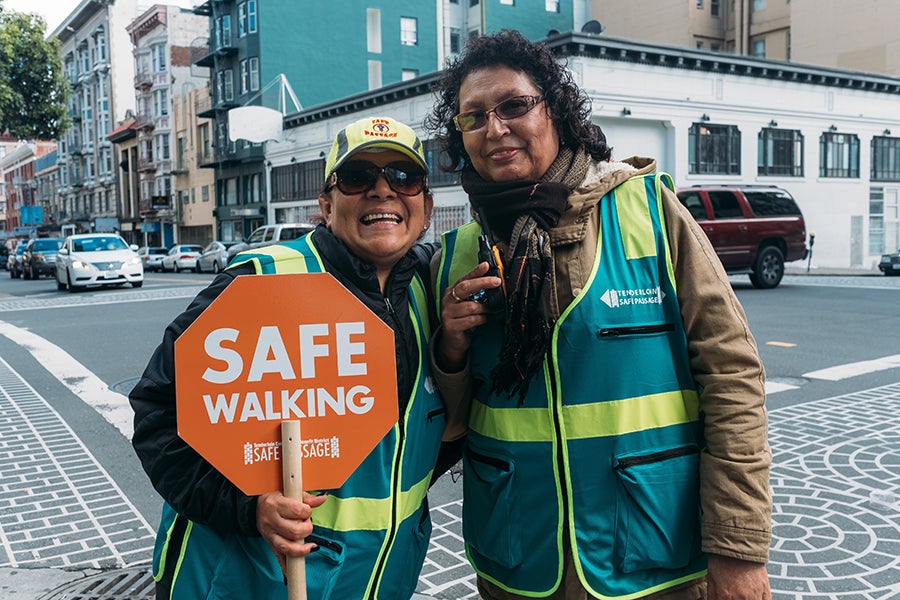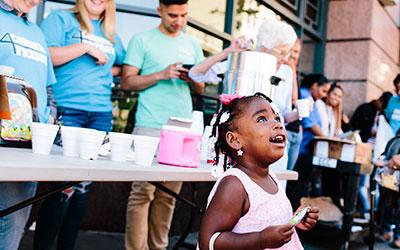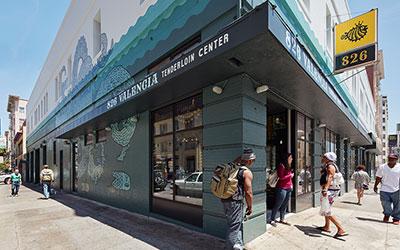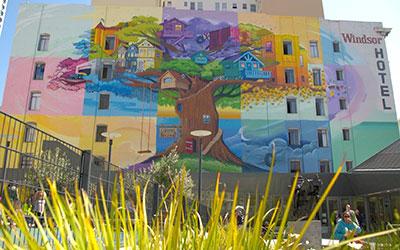
A Safe Passage for Students and Vulnerable Residents in the Tenderloin
Tenderloin Health Improvement Partnership Case Study
Safe Passage Corner Captains and volunteers are local residents who look out for kids and seniors and help make traversing the neighborhood easier. | Photo courtesy of Tenderloin Community Benefit District
By Bob Kehoe
Overview
Tenderloin residents, particularly children, face an abundance of everyday challenges. Students getting to and from school or after-school programs sometimes have to travel sidewalks crowded with drug dealers and users, the homeless and others. Kate Robinson, program director for the Tenderloin Community Benefit District, says over the years it’s been a difficult environment for school children and the elderly.
“There would be rows and rows of people on the sidewalk. You could smell all kinds of different smoke. It sometimes felt safer to walk in the street because the sidewalks would be so thick and crowded with drug dealing and drug use, which often can lead to fights and arguments,” says Robinson.
In 2008, after a child went missing during summertime programming, things came to a head, Robinson recalls. The child was located, but the event sparked outrage among parents. A group of mothers from La Voz Latina del Tenderloin soon called for a volunteer-led Safe Passage program to provide kids with a more secure way to get to and from school and after-school programs. In 2012, volunteers kept watch at high-risk intersections as children followed a Safe Passage mural painted on the sidewalk, depicting a route that linked schools to housing, recreation centers and programs.
The program helped, but initially it wasn’t easy to recruit volunteers or provide the consistent presence needed to ensure the children’s safety. Parents and others who wanted to help were sometimes fearful of how drug dealers and users might respond or retaliate against Safe Passage volunteers.
Impact
In 2012, Safe Passage gained fiscal sponsorship from the Tenderloin Community Benefit District, which sought grants to buy vests and walkie-talkies for volunteers. Still, the group lacked some of the organizational and operations skills to ensure long-term sustainability. A 2014 commitment of funding and technical expertise from the Tenderloin Health Improvement Partnership, a partnership of Saint Francis Memorial Hospital and the Saint Francis Foundation founded in 2013, helped provide the long-term stability the organization needed to cement its leadership team and begin expanding the program.

This before and after photo shows the impact of the Safe Passage team on one busy corner of the Tenderloin on an average afternoon. Negative activity clears out as the Corner Captains take up positon and children are escorted through the neighborhood to their homes and after-school activities. | Photo courtesy of Tenderloin Community Benefit District
As a result, the program began offering key corner captains a stipend for their work and the volunteer base grew. Co-investment from the Mayor’s Office of Economic Workforce Development and Vision Zero extended the Safe Passage footprint and allowed for chaperone services to be made available to seniors.
“With safety being the number one priority of residents in the Tenderloin, we believed in the potential of Safe Passage to be a safety game-changer in the community from the earliest days of TLHIP,” says Jennifer Kiss, vice president of programs at the Saint Francis Foundation and TLHIP director. “Since 2014 we’ve funded Safe Passage in various ways and it has grown exponentially. They now have corner captains who go out every day. It’s grown from a small volunteer-based organization to having some full-time staff and a lot of community resident volunteers who are paid a stipend to help kids and seniors traverse the neighborhood.”
In 2016, Safe Passage officially came under the umbrella of the TLCBD with Robinson acting as the program director. As a program of TLCBD, Safe Passage has stayed true to its grass roots origins while solidifying the operational and organizational footing to grow.
Robinson says the group now has 24 corner captains and provides morning and afternoon service for the community. And even though drug dealers and users still have a strong presence in the Tenderloin, she says Safe Passage volunteers have regular dialogue with these people, changing the calculus of civility in the neighborhood.
The Safe Passage initiative also has brought pride back to this impoverished area of the city. In their daily “activations,” the Safe Passage team helps to keep the sidewalks clean, something a growing number of businesses in the Tenderloin’s 30-block area are doing these days. The CBD also has a Clean Team that works seven days a week providing supplemental services like sidewalk and gutter cleaning, wiping down of public fixtures, deodorizing, etc.
Challenges remain, but Robinson says the way the various organizations have coalesced to bring meaningful change to the Tenderloin has been impressive. And she’s grateful for the role the Saint Francis Foundation has played in the progress that’s been made, both financially and in other forms of support.
“We wouldn’t exist without Saint Francis Foundation. We would probably still be a volunteer organization doing what we could,” Robinson says, adding that the Foundation provided far more than money. “They didn’t just hand us a check and say, ‘You’re on your own.’ For two years, they had weekly check-in calls with us and offered coaching sessions, guidance and advice. They connected us with other organizations [and potential funding sources] and helped us tell our story.”
That brought additional resources and a sustained, positive volunteer presence dedicated to improving safety in the Tenderloin.

The happy faces of Safe Passage Corner Captains looking out for their kids and their community. | Photo courtesy of Tenderloin Community Benefit District
Lessons learned
Supporting the Safe Passage program also has also taught Saint Francis Foundation staff some important lessons about the importance of working across the community rather than vertically with one organization at a time.
Kiss says expanding community connections was vital to the efforts to bolster Safe Passage.
“We saw there was a lot of yearning for how we can strengthen the community fabric and build bridges together to face some of these challenges. Some of it may have come from the early TLHIP meetings where people began to realize there were other people facing the same challenges. When you bring people together, that strengthens their sense of solidarity about what they’re experiencing,” Kiss says.
In communicating with and listening to the groups, a realization set in among the participants that they were stronger together than when acting alone, especially when their work was aligned to a common objective. They began to focus on how to build the community fabric to work differently together.
Future goals
Robinson hopes to maintain and build on the momentum that has been created with the Safe Passage program by expanding the role of corner captains as they develop both leaders and professionals and to transition volunteers to paid staff.
“We’d like to expand our presence to other places like additional parks or senior meal sites. We also want to help neighborhood block groups by providing assistance during their daily street-cleaning activations. Finally, we want to build our capacity to provide training and technical assistance to other communities interested in similar programs,” Robinson says.
Contact
Jennifer Kiss
Vice president of programs, Saint Francis Foundation
Director, Tenderloin Health Improvement Partnership
jkiss@saintfrancisfoundation.org
Jennifer Varano
Director, community health, volunteer services, emergency management
Saint Francis Memorial Hospital
Jennifer.varano@dignityhealth.org
Kate Robinson
Program Director
Tenderloin Community Benefit District | Tenderloin Safe Passage
kate@tlcbd.org
Download a print-friendly PDF of this case study





